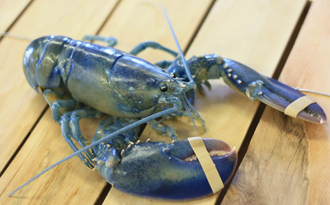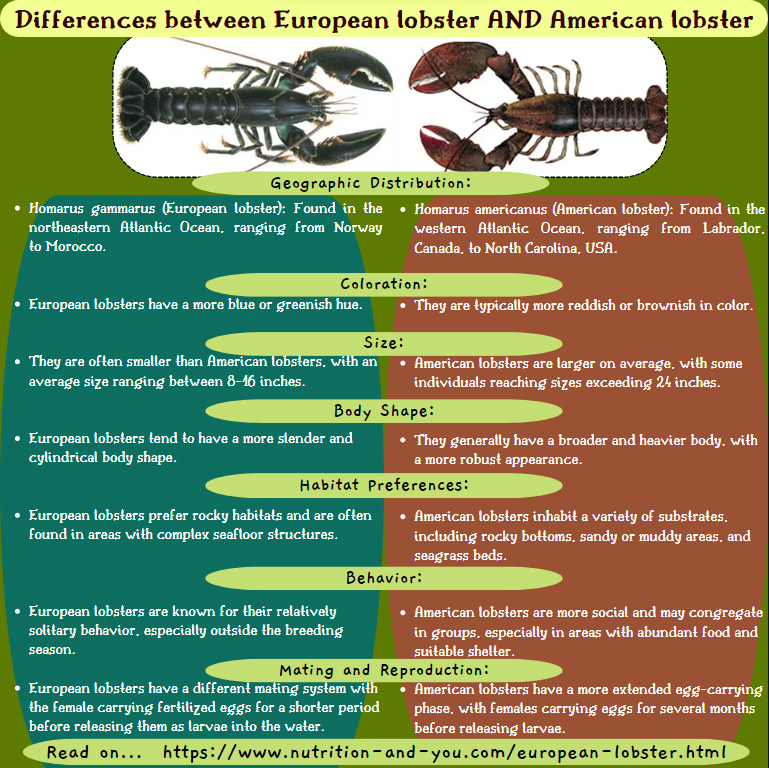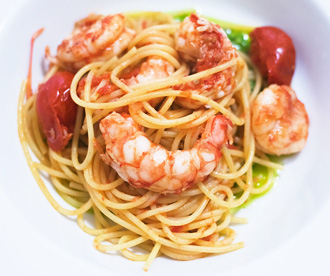European Lobster
The European blue lobster is a highly prized species of lobster found in the eastern Atlantic Ocean and the Mediterranean Sea.
Its delectable meat is highly cherished within gastronomic circles. It is also commonly referred to as the common lobster or the French Breton lobster. Scientifically this crustacean of the order Decapoda is known as Homarus gammarus.
 |
| European Blue Lobster. Photo: Richard Wood |
Description
The European lobster are larger crustaceans naturally occurring in liveing in the cold, temperate waters of the Eastern North Atlantic, from Norway down to Morocco.
The lobster is completely enclosed in a tough chitinous shell (exoskeleton), safeguarding its soft organs inside. The front of the exoskeleton forms a pointed rostrum that protects its large, compound eyes. While vision is crucial, lobsters rely on long, whip-like antennae for sensitivity to vibration and touch, particularly in low-visibility conditions.
The growth of a lobster involves molting or ecdysis, where it sheds its hard exoskeleton. Prior to each molt, a fresh, soft, and flexible shell is formed inside the existing one.
Blue lobsters possess 5 pairs of legs. The first pair is significantly enlarged and transformed into claws, with distinct roles: one functions as a cutter, and the other as a crusher.
Habitat
European Lobster lives on the sea bed and inhabit the coastal area from the intertidal zone down to about 60 m depth. The lobster is a solitary animal, except during mating periods, seeking refuge in some form of shelter for most of the time.
Despite its hard shell the lobster has a number of predators including octopuses, sizable fish like cod, dogfish, and conger eels, as well as seals. Their diet has a wide range from hunting live prey like mollusk, small fish and scavenging on dead organisms.
Biology
European blue lobsters typically reach sexual maturity within their second or third year of life. Mating occurs, typically in the soft-shelled post-molt phase. During mating, the male transfers sperm to the female's sperm receptacle.
Fisheries
Fishermen catch blue lobsters commercially with pots or ring nets.
See the differences between European lobster (Homarus gammarus) and American lobster (H. americanus) in an infographic:
 |
Health Benefits of European Lobster
European Blue lobster is a delicious and low-caorie seafood option, offering several essential nutrients. 100 g (3.5 oz) servings of its meat contains just 77 calories and less than 1 gram of fat.
Its lean, white meat is as an excellent source of protein, containing 16.5 g/100 g (equivalent to 29% of the Recommended Daily Intake). Lobster meat protein is complete in the sense that it provides all essential amino acids in a healthy proportion for cell repair, muscle development, and overall growth in the body.
It is a good source of omega-3 fatty acids, particularly EPA (eicosapentaenoic acid) and DHA (docosahexaenoic acid). These healthy fats are crucial for heart health, brain function, and reducing inflammation in the body.
Omega-3s are known for their potential to lower the risk of heart disease, support cognitive function, and promote joint health. The American Heart Association recommends seafood due to its diverse range of nutrients, essential fatty acids, vitamins, and minerals that play vital roles in metabolic functions.
Blue lobster meat also provides vitamins A, D, E, and B-complex vitamins like B-12, folate, niacin, pyridoxine, thiamin, and riboflavin.
100 g fresh lobster meat provides 1.25 μg or 55% of daily-required levels of vitamin B-12. Vitamin B12 plays a crucial role in supporting red blood cell formation, neurological function, DNA synthesis, and overall cell metabolism within the body.
Blue lobster are excellent sources of minerals. 100 g or 3.5 oz servings contain daily intake levels of 23% of phosphorus, 115% of selenium, and 150% of copper, 32% of zinc, and 4.25% of potassium.
Lobsters per se contains very tiny but permissible levels (0.107 Parts Per Million (PPM)) of methyl-mercury, making it a safer choice, especially for pregnant women and young children. The Food and Drug Administration (FDA) recommends that pregnant women consume at least 8 to 12 ounces (about 340 grams) of seafood with low mercury content per week.
| Principle | Nutrient Value | Percent of RDA |
|---|---|---|
| Energy | 77 Kcal | 4% |
| Carbohydrates | 0 g | <1% |
| Protein | 16.5 g | 29% |
| Total Fat | 0.75 g | 3.75% |
| Cholesterol | 127 mg | 42% |
| Dietary Fiber | 0 g | 0% |
| Vitamins | ||
| Folates | 10 μg | 2.5% |
| Niacin | 1.59 mg | 10% |
| Pantothenic acid | 1.45 mg | 29% |
| Pyridoxine | 0.104 mg | 8% |
| Riboflavin | 0.014 mg | 1% |
| Thiamin | 0.02 mg | 1.7% |
| Vitamin-A | 4 IU | <1% |
| Vitamin B12 | 1.25 μg | 52% |
| Vitamin-C | 0 mg | 0% | Electrolytes |
| Sodium | 423 mg | 28% |
| Potassium | 200 mg | 4.25% |
| Minerals | ||
| Calcium | 84 mg | 8.4% |
| Copper | 1.35 mg | 150% |
| Iron | 0.26 mg | 3% |
| Magnesium | 38 mg | 9.5% |
| Manganese | 0.056 mg | 2.5% |
| Phosphorus | 161 mg | 23% |
| Selenium | 63.6 μg | 115% | Zinc | 3.53 mg | 32% |
| Omega-3 fats (PUFA) | ||
| EPA (20:5 n-3) | 0.102 g | -- |
| DPA (22:5 n-3) | 0.006 g | -- |
| DHA (22:6 n-3) | 0.68 g | -- |
Buying
Choose a live European lobster from a reputable seafood market to ensure the highest quality and freshness. European blue lobster is characterized by its striking blue hue. The color may vary, but a healthy blue lobster should have a noticeable blue tint.
Examine the lobster for any signs of dirt, debris, or abnormal growths on its shell. A clean and well-maintained appearance is indicative of a healthy lobster. Avoid those with a strong, unpleasant odor, as this may indicate deterioration or spoilage.
Storing
European blue lobsters, like other lobsters, should be kept alive until you are ready to cook them. Lobsters are perishable, and keeping them alive ensures freshness. So, keep them in cold, saline water in a tank. Avoid overcrowding if you have bought too many lobsters.
Preparation
Remember, handling large and live lobsters requires caution. They have sharp claws and can pinch, so handle them carefully.
To prepare, fill a large pot with enough water to cover the lobster completely. Add salt to the water; about 2 tablespoons per gallon is a common ratio. Bring the water to a rolling boil.
Quickly and carefully place the live lobster headfirst into the boiling water. You can also use a long pair of tongs to lower it in slowly.
Boil it for about 8-12 minutes per pound. For example, if your lobster weighs 2 pounds, you would boil it for 16-24 minutes. The shell should turn bright red, and the meat should be opaque.
Use lobster crackers and picks to crack open the shell and extract the meat. Don't forget the meat from the claws and legs. Gently twisting off the legs and claws to separate meat.
The yield of lobster meat is approximately 30-35%.
Here are some serving ideas:
European blue lobster is a delicious and versatile ingredient that can be used in various recipes, from soups and luxurious and decadent main dishes like lobster lasagna.
Due to their rarity and unique coloration, there is a demand for blue lobsters in the culinary and seafood markets, particularly among consumers looking for exclusive and high-end dining experiences.
European lobster has sweet, briny and tender body meat and slightly firmer claw meat.
 |
| Lobster spaghetti with tomato. Photo: Piero Damora |
Enjoy blue lobster with garlic butter sauce, season with salt and pepper to taste. Sprinkle chopped fresh parsley over the lobster. Serve with lemon wedges on the side for squeezing over the lobster.
Prepare French-style smooth, creamy, lobster bisque with melt butter and sauté onion, carrots, celery, and garlic. Serve hot, garnished with fresh parsley.
Grill lobster tails with olive oil and sprinkle with garlic powder, paprika, salt, and pepper. Serve with lemon wedges.
Prepare European lobster pasta with creamy Alfredo Sauce. Add Parmesan cheese and stir until the sauce is smooth. Season with salt and pepper, and garnish with fresh parsley before serving.
Safety profile
Some individuals may be allergic to shellfish, including European lobsters. Allergic reactions can range from mild to severe, so individuals with shellfish allergies should avoid consuming lobster.
To maintain safety, ensure that lobsters are stored and handled properly to prevent foodborne illnesses associated with lobster consumption. Cooking lobster thoroughly is crucial to kill potential harmful bacteria.
Lobsters are generally low in mercury compared to some other seafood like albacore tuna, composing just 0.107 Parts Per Million (PPM). According to the U.S. FDA guidelines for expectant and breastfeeding mothers, blue lobster falls into the "best choice" category, allowing for 2-3 servings per week. (Medical disclaimer).
Also read ≻≻-
≺≺ Lobster nutrition facts and health benefits.
≺≺ Blue Crab nutrition facts and health benefits.
≺≺ Shrimp nutrition facts and health advantages.
≺≺ Sea Scallops nutrition facts and health benefits.
≺≺ Back to Seafood from European Lobster nutrition facts and health advantages.
Further reading (Links opens in new window):
European lobster- INSTITUTE OF MARINE RESEARCH.
European lobster- Homarus gammarus .
Omega-3 Fatty Acids: An Essential Contribution.
European Commission: Species- Homarus gammarus.